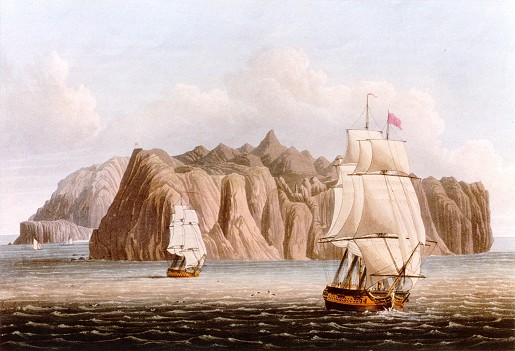History of Saint Helena

The coastline of St. Helena from Views of Saint Helena by G.H. Bellasis, 1815.
Other plates from Bellasis
The following is a very brief summary of the history of St.
Helena. Much greater detail can be found in various sources among the
St. Helena literature.
Early St. Helena
The island was discovered on 21 May 1502 by the Portuguese navigator Juan da Nova Castella and was named for Saint Helena, the mother of Constantine the Great. St. Helena was thereafter used by the Portuguese as a watering and victualling base for their fleets returning from the East Indies and, as far as possible, the existence of the island was kept secret by the Portuguese. In 1588 the English circumnavigator Thomas Cavendish of HMS Desire located the island. Over the following years, the Portuguese, English, and Dutch all used St. Helena for victualling their East India fleets; in 1633 the island was formally annexed by the Dutch although never occupied.
The English East India Company
Not until May 1659 did St. Helena become settled, when the English East India Company claimed the island and colonised it under a charter from Charles II. The first inhabitants were company employees and English settlers, accompanied by slaves from South Asia (Goa), the East Indies (Malaya), and Madagascar. An influx of new settlers followed the Great Fire of London.
The Exile of Napoleon
The fortunes of St. Helena changed drastically with the exile there of Napoleon in 1815. A large garrison was established on the island and naval ships were on constant patrol in case of a rescue attempt. The remains of the fortifications, including numerous rusting cannon, are still evident in many places around the island. Upon Napoleon's death in 1821 nearly all of the garrison was withdrawn.
A Crown Colony
The collapse of the English East India Company led to their inevitable withdrawal from St. Helena and the island became a British Crown Colony in 1834. With this transition the relative prosperity of the island vanished. Darwin, who visited St. Helena in 1836 when homebound on the Beagle, remarked that "so little level or useful land is there, that it seems surprising how so many people, (about 5000) can subsist. The lower orders, or the emancipated slaves [slavery was abolished in 1832], are, I believe, extremely poor; they complain of want of work; a fact which is also shewn by the cheap labour. From the reduction in number of public servants owing to the island being given up by the East India Company & consequent emigration of many of the richer people, the poverty probably will increase".
The fortunes of St. Helena waned further with the opening of the Suez Canal in 1869 which caused a large decrease in the number of ships visiting the island.
St. Helena again became a place of exile in 1890 (Dinizulu, the son of Cetewayo, and his entourage were confined on the island) and from 1900 to 1902 (6,000 Boer prisoners of war were camped on Deadwood Plain and Broad Bottom).
In the early part of this century the island economy became almost totally dependent upon a single commodity - New Zealand flax was planted over a large area of the central part of the island and was cut and processed for the manufacture of rope and string. The demand for flax disappeared in 1966. Although there has been significant flax clearance since, flax still covers some areas of the interior of St. Helena.
Page maintained by Barry Weaver